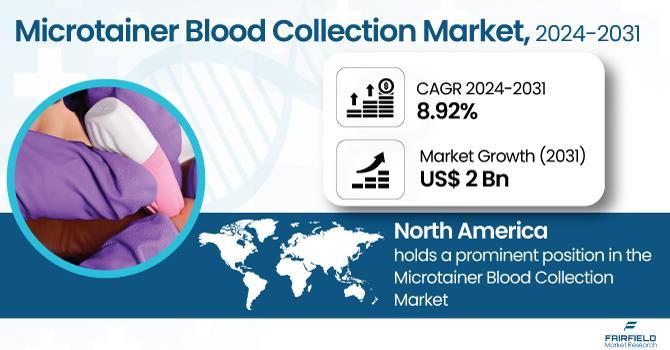Microtainer Blood Collection Market
The global microtainer blood collection market is projected to witness substantial growth over the forecast period, with estimations indicating a surge from US$1.1 billion in 2024 to a staggering US$2 billion by 2031. This remarkable expansion is attributed to several key factors driving demand and innovation within the industry.
For more information: https://www.fairfieldmarketresearch.com/report/microtainer-bloodcollection-market

Market Growth Trajectory: From Past to Future
The period between 2019 and 2023 witnessed significant growth in the microtainer blood collection market, fueled by factors such as the increasing adoption of point-of-care testing and technological advancements. From 2024 to 2031, the market is poised for continued growth, primarily due to the rising geriatric population and the growing focus on home healthcare. Investments in technological advancements, including automation and integration with diagnostic systems, are anticipated to create lucrative opportunities for market players.
Key Growth Determinants
Technological Advancements: Innovations in blood collection techniques and devices, including smaller and more efficient microtainer tubes, are enhancing patient comfort and reducing sample contamination risks.
Rising Demand for Point-of-Care Testing (POCT): The need for rapid diagnostic results and decentralised healthcare delivery is driving the demand for microtainer tubes, enabling convenient blood collection at the point of care.
Growing Prevalence of Chronic Diseases: With the increasing burden of chronic diseases globally, there is a corresponding rise in the need for regular blood testing and monitoring, driving the expansion of the microtainer blood collection market.
Major Growth Barriers
Regulatory Hurdles: Stringent regulations regarding product safety, quality control, and sterilisation processes add complexity and costs to manufacturers, potentially hindering market growth.
Limited Awareness: Despite the benefits of microtainer technology, limited awareness among healthcare professionals and patients may impede market expansion.
Healthcare Infrastructure: In regions with underdeveloped healthcare infrastructure, adoption of microtainer blood collection systems may be slow due to inadequate training of healthcare staff and logistical challenges.
Key Trends and Opportunities
Digital Transformation: Leveraging digital technologies can optimise supply chain management, improve patient data management, and facilitate seamless communication between healthcare providers and patients.
Sustainability Drive: Investing in eco-friendly packaging, implementing energy-efficient manufacturing practices, and promoting reusable or recyclable blood collection devices can capitalise on the trend towards sustainability.
Miniaturisation and Portability: Developing innovative microsampling technologies and portable blood collection kits can cater to the growing demand for compact, portable, and easy-to-use blood collection devices.
Regional Frontrunners
North America: With a robust healthcare infrastructure and favourable reimbursement policies, North America stands out as a beacon of innovation in the microtainer blood collection market.
Europe: The emphasis on healthcare quality and innovation, coupled with universal healthcare coverage and stringent regulatory standards, drives steady growth in the European market.
Competitive Landscape
Leading companies such as Becton, Dickinson and Company (BD), Greiner Bio-One, and Terumo Corporation dominate the market with extensive product portfolios and strategic investments in research and development. Emerging players focus on niche markets and digital platforms for marketing and distribution to gain a foothold in the competitive landscape.
